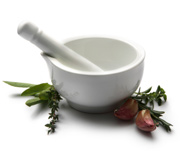
|
Kicking the Antacid Habit: Healing Heartburn Naturally With all the advertising for pharmaceuticals on TV, you begin to wonder if you are normal if you aren't taking several medications. One of the most overused medications is the antacid pill, e.g., Nexium (the "purple pill"), Pepcid AC, Tagamet and Tums. Anyone who has suffered reflux (food and acid coming back up the esophagus), heartburn or gas and bloating has most likely taken one of these pills. When someone produces too much acid, these medications can be quite helpful. But the majority of people who get heartburn do not produce too much acid, and taking these medications for more than several weeks can cause many complications that the public rarely hears about. Your stomach is an amazing organ. Its innermost lining is completely replaced every day. It produces hydrochloric acid (HCl) to break down protein and sterilize food against bad bacteria. The acid is so strong, if you were to extract it from your stomach and place it on your arm, it would burn a hole through your skin. A Common Misconception: Contrary to TV ads, studies show that much of the U.S. population has too little stomach acid and could benefit from taking HCl. The lack of stomach acid comes from chewing quickly, overeating and feeling stress during a meal. Taking antacids leads to poor utilization of zinc, calcium, magnesium and vitamin C, because these nutrients need an acidic environment to be absorbed. If a study were to be done on Nexium users, I could almost guarantee it would show a high incidence of osteoporosis. In addition to the above nutrients, the gall bladder and pancreas are also affected by the lack of stomach acid. The enzymes they secrete for digestion are determined by the acidity of the partially digested food leaving the stomach. Without the proper amount of enzymes, the food is not broken down and creates inflammation in the intestines. I have seen many cases of ulcerative colitis and irritable bowel syndrome (IBS) preceded by the prolonged use of antacids. Care for Kids: Lack of HCl has also been connected to immune system problems. In one study, 80 percent of asthmatic children had levels of HCl below normal; the non-asthmatics had only 10 percent with similar levels. When asthmatic children were given HCl, their asthma attacks were shorter and less intense. Clearly, even children need proper amounts of HCl, but unfortunately, I've seen a new trend toward giving antacids to infants. In the last month I've had two mothers bring in their six-month-old babies who had bad cases of reflux or "spit up." Both babies' pediatricians had recommended small doses of a prescription-strength antacid. I was left speechless. While not all pediatricians would recommend this, it demonstrates the pharmaceutical industry's deep roots in the medical profession. Kicking the Antacid Habit: If you take an occasional antacid or just get some bloating with meals, then it is generally safe to take about 600 - 1,200 milligrams, or about 1 - 2 pills, of HCl (often listed as Betaine HCl on supplement labels) with each meal. Do this consistently for about one month, then stop and see how you feel. You may need to take HCl for several months before your stomach produces it on its own. If you are taking a regular antacid, then I suggest taking a stomach-repair formula containing 500 mg of Deglycrrhizinized Licorice (DGL), 400 mg of L-Glutamine and 200 mg of Aloe Vera. Most stores sell this all in one bottle with only slight variations. This combination acts like an antacid by helping with reflux, but it doesn't stop HCl production. Unlike an antacid, it actually helps heal the stomach and coats it naturally. The goal is to heal the stomach and then introduce HCl soon after. The formula below has been used hundreds of times in our office and is very effective for healing reflux and getting off antacids. Consult your healthcare provider before starting this program. Week Antacid HCl Repair Formula
If at any time you get excessive burning in your stomach with the HCl and/or when stopping the antacids, discontinue the supplements and consult your doctor. Most people find that after following the above regimen, they can stay off antacids and don't need to keep taking the repair formula. Most people need to keep taking HCl for another 1 - 2 months to let the stomach produce enough of its own acid. After this time, they usually will not need it except for after large or hurried meals. I take one tablet in cases like these. Certain people need to keep taking HCl if they have a familial predisposition towards not producing enough HCL or if they frequently rush through meals. You can determine that you need HCl if, after stopping it, your symptoms of reflux return. The best way to avoid any digestive problems is to eat slowly, bless your meal and eat healthy food. My family and I have made a conscious effort to say a prayer and give thanksgiving before each meal, causing us to slow down and appreciate our food. Bon appetite. |
